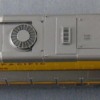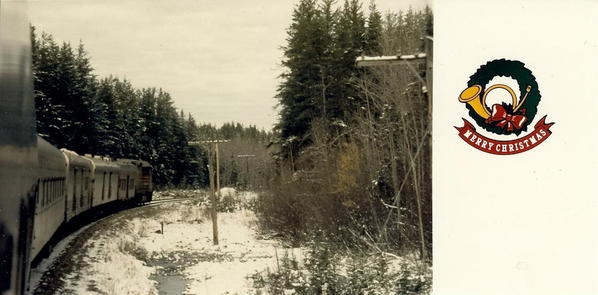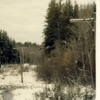The title says it all. Were these styles of loco used regularly on any passenger services? If so, what style of car, and type of service? And which railroads did this?
Replies sorted oldest to newest
I know for a fact that the newly delivered GP30s on the Norfolk & Western were used in passenger service, in 1962. The real problem for all us modelers though; the N&W, as well as the Southern Railway, GP30s were HIGH SHORT HOOD!
New Jersey Transit still uses GP40's for passenger service.
ChessieFan72 and drelo,
The original poster inquired about GP30 models in passenger service.
Neither the GP35 NOR the GP40 look ANYTHING like a GP30!
By the way, EMD models do NOT have a "dash" between the "type" and the number series.
What sort of passenger cars were pulled on the N&W and Southern?
The B&O used the GPs for passenger and freight operations. Examples of both are preserved in operating condition in the B&O Museum. The B&O Museum also has a B&O "Sunburst" GP30 in operating condition, used somewhat regularly to pull excursion trains. It is in excellent mechanical condition but in rather poor cosmetic shape, in dire need of paint. The museum also uses GP38, GP9, GP7, etc, etc for switching and passenger operations as well as an SD-35 and various EMD SW switchers and an EMD F7 AB combo.
MARC commuter service still uses GP39s for shorter trains as well as keeps one old GP40 as a protect locomotive. MP36s are the primary locomotives now hauling most diesel trains. VRE (Virginia Railway Express), ran their service for many years using GP-40 rebuilds. All have been retired in favor of new MP36 units.
Western Maryland Scenic Railroad has 2 GP30s, #501 and #502, both painted in the Western Maryland "Speed Lettering" scheme. I was fortunate to operate GP30 #502 for a good chunk of time over a portion of their railroad last year. What a thrill it was!
Any loco could pull a passenger train. The real question is whether they were equipped with boilers for train heating, which is the mark of a purpose-built passenger loco before Amtrak converted to HEP. Locos intended for passenger service also had special air-brake equipment. The GP30's were built at a time when passenger trains and services were being scaled back, and most railroads still had plenty of older E units for passenger service. Diesel locos equipped for passenger service weren't as convenient to use for mainstream freight service because the water tanks for boiler supply typically displaced fuel capacity, and the traction motors might be geared for higher speed, not so good for freight service.
In the 1960's few railroads were buying new locos for passenger service. Union Pacific bought 10 SDP35 locos equipped for possible passenger service - in a fleet of hundreds of locos. Those were probably the last locos UP bought new with boilers for train heating. The boilers were removed from them after Amtrak took over the passenger trains in 1971.
It would be interesting to hear some specifics about GP30's equipped for passenger service - I think they must have been kinda rare. Was there room for a train-heating boiler in a high short hood? Some GP9's were set up that way.
UP did buy eight GP30 "B" units (aka no cab) with boilers and water tanks for passenger service. They ran an ABB consist.
I love running my B&O passenger train with my Williams GP9s, but I've also been pondering running my NYC passenger train with the new GP30 I just got from WBB.. So this is an interesting thread.
I love running my B&O passenger train with my Williams GP9s, but I've also been pondering running my NYC passenger train with the new GP30 I just got from WBB.. So this is an interesting thread.
I'm thinking of doing the same. Would they have pulled heavyweights, or were they out of service by the 60's?
ChessieFan72
The original poster inquired about GP30 models in passenger service.
Neither the GP35 NOR the GP40 look ANYTHING like a GP30!
"GP30's and the like" sounds to me like GP30's and like diesels, which would include...surprise, GP35's and 40's. Perhaps instead of playing Mr. Correctness, you take a step back, since your answer had nothing to do with the topic.
I love running my B&O passenger train with my Williams GP9s, but I've also been pondering running my NYC passenger train with the new GP30 I just got from WBB.. So this is an interesting thread.
I'm thinking of doing the same. Would they have pulled heavyweights, or were they out of service by the 60's?
the only NYC passenger trains I saw in person were westbound out of Indianapolis, to St. Louis and Chicago. Those were all in the early 60's and all had streamlined cars save for the occasional Madison baggage car. But so what? If you have a set of heavyweights, run 'em :-)
UP did buy eight GP30 "B" units (aka no cab) with boilers and water tanks for passenger service. They ran an ABB consist.
Interesting ... and more info:
http://d1ke3s7oc9e1xt.cloudfro...1d45_46e9.jpg?c=8a6a
"Union Pacific obtained its 152 GP30s in several orders (1962-1963) ... the third group consisted of 40 boosters, numbered 700B - 739B ... Of these, units 727B - 739B came with steam generating equipment. Only the Union Pacific ordered the GP30B ..."
An interesting detail, later versions of GP30's have a cab 10" longer on the fireman's side to allow space for an extra seat.
This HO model of a GP30B clearly shows the boiler stack at right.
My first cab ride on Union Pacific was on GP35 #743; it's somewhat interesting to note that it was numbered right after the last of the GP30's.
Attachments
Southern Pacific used a GP38P-2 for commuter service. I'm guessing it had modifications for head-end power.
Southern Pacific used a GP38P-2 for commuter service. I'm guessing it had modifications for head-end power.
I dunno about GP38P-2's on SP. SP had three GP40P-2's, new in 1974; I suspect they replaced FM's in San Francisco commute service, retired that year. GP40P-2's might have still had boilers or else SP would have had to upgrade the commute cars too. http://www.trainweb.org/jaydeet/gp40-2.htm
http://enc.tfode.com/EMD_GP38P-2
A total of 31 GP38-2s were built with high-short-hoods containing steam generators for passenger service on Mexican railways.
I love running my B&O passenger train with my Williams GP9s, but I've also been pondering running my NYC passenger train with the new GP30 I just got from WBB.. So this is an interesting thread.
I'm thinking of doing the same. Would they have pulled heavyweights, or were they out of service by the 60's?
the only NYC passenger trains I saw in person were westbound out of Indianapolis, to St. Louis and Chicago. Those were all in the early 60's and all had streamlined cars save for the occasional Madison baggage car. But so what? If you have a set of heavyweights, run 'em :-)
Oh I will, and I have the streamlined car sets. I always run what I like, but, not being an expert on US trains, I like to know the history and the prototypical information. It just adds richness to my enjoyment of the hobby. It's interesting how Madison baggage cars did survive. One of my favorite trains to assemble, is the Robert Kennedy funeral train. The consist also was streamliners with a Madison baggage car, and 120 Observation car for the coffin.
UP did buy eight GP30 "B" units (aka no cab) with boilers and water tanks for passenger service. They ran an ABB consist.
Chuck, that makes for a very interesting project.
From what I've dug up it appears the boiler-equipped GP30B's saw mostly secondary passenger service, and only from 1963 to early 1970's ...
http://utahrails.net/articles/up-gp30s.php
The later cabless booster units, UP 700B-726B were ballasted to 258,800 pounds. UP 727B-739B were equipped with steam generators for passenger service. Steam generator equipped GP30Bs were used along with the 1400-class SDP35s on Vietnam-era troop trains. These troop trains operated between Fort Riley, Kan. and the West Coast. They were also regularly used on many of the road's secondary passenger trains. By the early 1970s all steam generators had been retired in place on the locomotives. UP 727B-739B had operating weights of 262,900 pounds in freight service and 272,100 pounds in passenger service.
http://www.rrpicturearchives.n...icture.aspx?id=78878
The UP received a total of 40 GP30B's from EMD, the first 27 (road #'s 700B-726B) were freight-only units, the rest (road #'s 727B-739B) were equipped with steam generators for standby passenger service.
Hows about a GP38 on the Algoma Central? Outside of the Canyon Train, long before the WC took over, the AC ran a local from one end to the other.
The steam generator car is ex-CN, coaches and baggage ex-CP, plus the occasional ex-DRGW baggage.
Algoma Central #1, Sault St. Marie -Hearst (from an old Christmas Card I used to send out)
Algoma Cental #2, Hearst - Sault St. Marie:
All stops, including flag stops for outdoorsmen.
Rusty
Attachments
Dave, feel free to run whatever looks good to you! Overly-vocal rivet-counters can be invited to use the exit door. Although, I appreciate knowing the background on all these things to retain some semblance of semi-credibility in my miniature train world. If necessary you can make a good BS story that your locos have integral HEP power for your HEP-retrofitted passenger cars.










